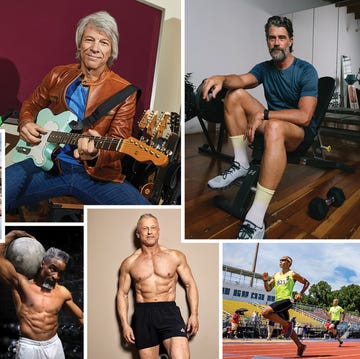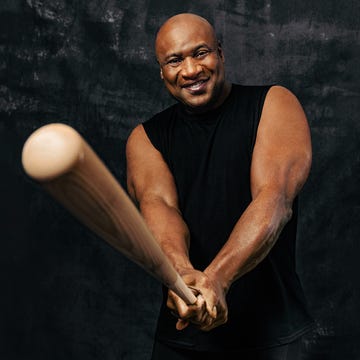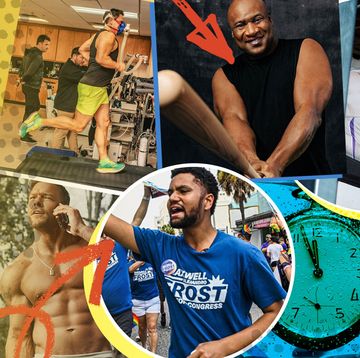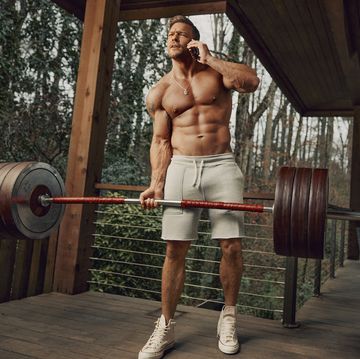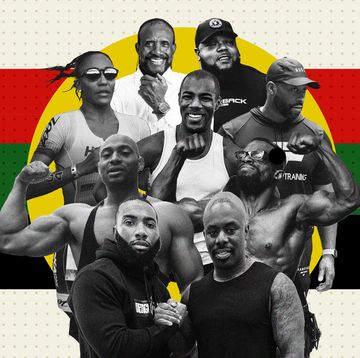IF YOU KNOW anything about a Hästens bed, it’s likely the price. The Swedish company’s most popular mattress retails for around $60,000. But its premium offering, the Grand Vividus, will now run you an eye-popping $700,000. That bed, which was introduced in 2020, takes 600 hours to assemble by hand and features decorative corners and handles made from Indonesian stingray.
Drake was reportedly the first person to own a Grand Vividus, which resembles a Louis Vuitton trunk and is so heavy it can only be flipped by a professional. This was at least his second Hästens mattress, I was told, and he was a satisfied customer. In his 2018 song “God’s Plan,” Drake memorably rapped, “I only love my bed and my mama.” He’s in good company. Hästens’s blue-and-white-check print is perhaps the only thing Angelina Jolie and Russian president Vladimir Putin can agree on.
It’s a remarkable rise: A privately held sixth-generation family business from rural Sweden somehow becomes the luxury bed of choice for both Tom Cruise and Beyoncé (if Internet chatter can be trusted). That unlikely journey is chronicled in the new book When Business Is Love, the first from Hästens CEO Jan Ryde, who promised to pull back the curtains—or the covers, in this case—if the company passed $100 million in annual worldwide sales.
It’s a good time to be in bed with Hästens. While the mattress market has cooled since a pandemic spike, a recent Financial Times report found that the luxury-bed sector is still hot, outpacing the rest of the industry. Sales at Hästens have doubled in the past five years, with stores open in Dallas and Toronto, and opening soon in San Francisco and Seattle. As people have become increasingly obsessed with “optimizing” sleep to hack longevity, Ryde has smartly positioned Hästens not as a bed but as a wellness tool. His 368-page tome isn’t really about the numbers, anyway. It’s more like a woo-woo self-help book masquerading as a Harvard case study, with Ryde extolling the virtues of life as a human being, not a human doing. It is certainly the only business book I’ve read that includes the CEO’s recovered memories from his mother’s womb. (Jon Hamm narrated the audiobook, presumably for a free bed and then some.)
Call it Zen and the Art of Mattress Maintenance. In January, I traveled to Sweden to meet Ryde and discuss the family business and his celebrity fans, but really to ask a question the book doesn’t exactly answer: How good could a million-dollar bed really be?
THE HASTENS FACTORY sits 90 miles northwest of Stockholm in the small village of Köping (which for some reason is pronounced sherping). The building is like a mid-century-modern airport hangar, with oversized windows letting in a flood of natural light. Hästens has been an official bedding supplier of the Swedish royal court since 1952, and the office entranceway is lined with framed proclamations from the palace hanging beside fan letters from happy customers complete with baby photos. Move farther inside and you’ll find maybe 70 people working the factory floor, some massaging heaps of dark-gray horsehair into thin layers, others stitching mattress toppers. But what really stands out is how quiet the place is. So much of the work is done by hand you could hear a pincushion drop.
As Ryde tells it, it’s not very Swedish to write a book crowing about your family’s global achievements. “Swedish culture frowns on elevating one person over another,” he writes, recalling the time his car was egged by an angry critic: “Someone had such negative feelings for what I was working to accomplish at Hästens.” Ryde prefers to take his cues from his role model, Steve Jobs. A framed quote from an interview the Apple titan once did with Fortune magazine hangs outside the old Hästens cafeteria. It reads, “We do no market research. We just want to make great products.”
“Apple has made the telephone extraordinary,” Ryde explains. Presumably Hästens has done the same for mattresses. Ryde even dresses like Jobs—in a black turtleneck and dark pants.
Call him Swede Jobs. But the comparison holds. Instead of competing on price, he says, Hästens competes on quality. Each Hästens bed is filled with layers of hand-teased horse-tail hair. While synthetic-foam mattresses can trap heat, the hollow structure of horsehair allows it to breathe, helping to regulate your body temperature while you sleep. Temperature is critical to sleep quality, explains sleep specialist Rafael Pelayo, M.D., a clinical professor from Stanford University School of Medicine, who told me “cooler temperatures promote sleep,” adding, unnecessarily: Humans “always fall asleep before we freeze to death.”
Hästens mattresses range in price—the entry model is around $7,000—but the materials are basically the same. The biggest difference is the height and the number of springs, which can be gauged to a customer’s preference (from extra soft to extra firm), according to Linus Adolfsson, the top-selling Hästens dealer, who operates showrooms, also called “sleep spas,” in New York, Los Angeles, and Greenwich, Connecticut. “The number of springs can be described as ‘how many hands’ are holding your body,” he says. “It is the high number of individually hand-tied springs combined with the depth of the springs that creates the sensation of sleeping in a supported cloud.”
The Hästens origin story reads like Charles Dickens by way of Stieg Larsson. The company was founded in 1852 by Jan’s grandfather’s grandfather, Pehr Adolf Janson, whose mother died on Christmas Day when he was a child. He grew up impoverished and apprenticed as a saddlemaker. In the 19th century, it was part of a saddlemaker’s trade to learn to craft mattresses. But as the story goes, with the introduction of the motor vehicle, Pehr Adolf’s son, who had followed in his footsteps, saw the writing on the barn door and turned this side hustle into the company’s primary gig. (The word hästens is Swedish for “the horse’s.”)
Hästens has remained a family affair filled with all the drama you’d expect. In the 1960s, as cheap, mass-produced goods thrived, a branch of the family lost faith in the business and sold off its shares, only to regret it. When Hästens returned to prominence, those who’d jumped ship went full Logan Roy (or Lukas Matsson, in this case). When Ryde was a kid, he recalls, one vengeful relative would call every Christmas to snivel: “This is the year I’m going to make you go bankrupt.”
Ryde took over the reins from his parents in 1988—a fifth-generation nepo baby who was nearly a baby himself. He had very little experience but was clear-eyed on the challenges. “We were the best in the world at making beds,” he says, “yet not so good at selling them.” He was 25.
Ryde is not a natural salesman. A self-described “cross-eyed and shy” kid, he has a gentle demeanor and wears his near-white hair in a ponytail. Whereas Jobs had a superhuman ability to communicate, Ryde’s anecdotes tend to circle the drain before coming to a point. He isn’t even the hero of his own stories. His first wife divorced him, he tells me, because she was tired of defending him to his critics. When asked about the best night of sleep he ever had, Ryde remembers an early vacation to Bali with his now second wife and how he stayed up all night “just to watch her breathe.”
Having Don Draper narrate the audiobook makes perfect sense; Jon Hamm can make even the most banal passages feel like he’s pitching Lucky Strike. I assumed Ryde was a Mad Men fan.
“I’ve never seen Mad Men,” Ryde says in the Hästens break room, almost confused by the question, then adds: “I’ve seen Top Gun.” It takes a second for me to realize he’s talking about Top Gun: Maverick. I’d forgotten Hamm was even in that movie. But Ryde recalls being taken with his voice. “He has a great voice, right? I love Tom Cruise. Maybe I would’ve loved to ask Tom Cruise. Maybe I had a limiting belief. Maybe I should have asked Tom Cruise. Although I’m really happy with Jon.”
Identifying our own “limiting beliefs” is a big part of Ryde’s book. Over the decades, he brought in an outside CEO three times—most notably in 2010, during a time he refers to as the “Dark Ages.” The move was necessary. Divorced and disconnected from his kids, Ryde describes torturing himself by walking by their house every morning, staring in while they ate breakfast without him. Meanwhile, Hästens floundered. Without a firm hand at the top, the sales team was adrift. One salesperson openly declared his job impossible, complaining that everyone who could afford a Hästens already had one, and quit on the spot.
Ryde worked on himself. Intense therapy followed, including regression therapy, taking him back to his mother’s womb (which he describes as “warm and peaceful”). He came to see that he was standing in his own way. “There is an abundance of love available, an abundance of joy,” he says. “You can have anything you want in the universe. You can compete with yourself to get better, but you’re not competing with anyone else.”
“Sometimes it takes a crisis to make someone realize that they have been stuck,” he writes. The Dark Ages were, incidentally, the only time Hästens did not exclusively use Macs, Ryde told me.
Ryde resumed a more active role in the company in 2015 and returned as CEO in 2018, de-emphasized departmental budgets (which he realized create “negative energy”), and started dreaming big. But putting the right team in place was not without controversy. Ryde is said to keep a hypnotist on staff to advise him on employee matters. And in 2021, a former recruiter for Hästens sued the company, claiming she was pushed to hire employees based not on their qualifications but on their “vibrations.”
According to that same suit, Ryde was prone to making inappropriate remarks on Zoom calls, including the truly bizarre claim that “Vladimir Putin is happier since he bought a Hästens bed and now kills less people because of it.” That case was settled out of court. I have no idea if Ryde really said that. But it’s sort of in line with his sales pitch. Ryde suggests that those who sleep well live on average 20 years longer than those who don’t.
As he tells it, Ryde had to look inward to find the right pitch. “The physical product is our bed,” he says. “But we have a higher purpose. The mission is to make this world more loving, joyful, peaceful.” He wasn’t selling a mattress; he was selling a better you. You didn’t even need to wear one of those Oura rings to get it.
Launching the world’s most expensive bed during a global pandemic proved prescient. As Covid-19 raged and even billionaires had to shelter in place (or space, anyway), the $60 billion mattress sector surged. The Grand Vividus, introduced in 2020, now retails for around $700,000, but with tweaks it can reach well over $1 million. The bed is entirely made by hand. Since early 2022, Hästens has raised its prices in the U. S. three times. On March 5, the company will again raise its prices. There is currently an 11-month wait list for the Grand Vividus.
“We have tried making cheaper beds,” Ryde tells me, “and it doesn’t work for us to compromise. Even if someone buys an entry-level bed , we want it to last forever.”
HAVE WE REACHED peak bed? Savoir Beds, a competitor, sells a bed that can cost north of $300,000 and has a topper made from the hand-combed hair of “semi-wild yaks.” For a comparatively cheap $600, one might try the BedJet, which works like an HVAC for your bed (with the temperature adjusted by smartphone app). It’s now possible to cool one side of the bed only. Even Casper makes an adjustable frame.
But only one brand has been featured in both an episode of Emily in Paris and a Post Malone song. I ask Ryde to quantify Drake’s effect on the brand. Has the rapper’s frequent name-checking driven sales? It’s impossible to say, Ryde explains. Though he tells me traffic to the Hästens website spiked by the millions—a happening rivaled only by the juicy 2022 story of a high-profile divorce between a Taiwanese actress and her mainland-Chinese husband fighting over who would get to keep the marital Hästens. That the luxury market would be attracted to a bespoke Old World technique makes sense. What they’re offering is couture.
Reading the book, however, you’ll notice something is missing. Almost. The price of a Hästens bed isn’t mentioned until 178 pages in. Ryde briefly acknowledges that the company has been criticized for the costliness of its beds, though he argues they’re basically cheaper in the long run because they’re meant to last forever. (He doesn’t mention that the topper should be replaced every ten to 15 years at a cost of $7,500.) As he tells it, the price is beside the point. The bed isn’t a luxury product, he says, but something for the masses. “An investment in a [Hästens] is an investment in [your] own health,” he writes. “Our product is for everyone.”
The entry-level bed retails for about $7,000, which is $4,000 more than what the Four Seasons hotel mattress retails for. But credit to Ryde for not shying away from his claims. He tells me a long story about a woman from a low-income neighborhood of Los Angeles who spent seven years saving up to buy a Hästens in cash at the Beverly Hills store. Initially she was told the bed couldn’t be delivered because the ZIP code was deemed unsafe. I found the story to be depressing on about a dozen levels. But Ryde admired this woman for prioritizing her health.
But seriously: Who besides Drake would buy a million-dollar bed? Adolfsson, the Hästens dealer, introduced me to a client of his who bought a Grand Vividus—a 40-something man in Manhattan we’ll call Max. He didn’t want his name used because we’re in a period of quiet luxury and because he understands that his mattress cost more than most people’s homes. The bed is festooned with a golden brass plaque identifying it as a Grand Vividus, he tells me, but he actually had it installed backward to hide the name.
In a way, that’s good PR for the bed. It’s like buying a Lamborghini but never telling anyone. And he stands by the purchase (made possible, he stresses, by an early inheritance). Max suffers from insomnia, which he partially blames on anxiety, and the bed was part of a last-ditch cure effort. He recalls restless nights when he’d wake up ten or 15 times. The fatigue left him constantly battling flu symptoms. He mostly sleeps through the night now. “I’m a little bit embarrassed,” he says. “You hear these stories about NBA players, famous celebrities that buy these beds who have tens of millions of dollars. That’s not me. I own a two-bedroom apartment. But I’m going to make this crazy investment for my health.” Okay, but why did he choose the Grand Vividus over the comparably cheap Vividus, which retails for about $400,000 less? “Psychologically,” he says, “there’s the assurance that you’re getting the very best of what a company makes.”
Stanford’s Dr. Pelayo, the author of How to Sleep, echoes the point. “People who sleep less than average tend to die first,” he says, adding that William Dement, M.D., Ph.D.—who coined the term REM sleep—used to say the Fountain of Youth was in our bedrooms. Dr. Pelayo adds: “I don’t begrudge anybody’s wealth. If sleeping better on this mattress is a placebo effect, it’s a nice placebo. Sleep in general has a huge placebo effect, since our state of mind will influence our sleep. Sleeping-pill trials report more than a 30 percent improvement in their placebo arms. What happens is once you trust that something will help you sleep, then as that trust grows your sleep continues to improve.”
After our interview, Hästens’s head of North America wholesale, Robert Santarsiero, tours me around the company’s flagship store in Köping. Santarsiero grew up in New Jersey—the son of a furniture salesman—and it shows. He has a casual demeanor, asking about my bedtime and more specifically how I sleep (on my side, with a pillow between my legs).
He listens patiently, then offers: “When somebody’s putting a pillow between their legs, they’re not getting spinal alignment. Your bed is too firm. You put the pillow there to readjust.”
He walks me over to an $80,000 Hästens 2000T in soft. (It’s not the most expensive model but is, incidentally, the one Ryde sleeps on.) Santarsiero has me lie down and roll onto my side, tracing my spine, which is now apparently straight. Then he tucks me into a $2,200 duvet and steps back. “How do you feel?” Like I’ve just woken up from a colonoscopy, I think, high on Propofol.
“When you asked earlier, ‘How do we sell the beds?’ ” he says. “We sell the beds by asking these questions.”
For the record, I tried the Grand Vividus, too, but I could not tell the difference. Perhaps it’s like buying an expensive bottle of wine. Above a certain price point, you need a more refined palate to appreciate it. But my ten-year-old mattress is on notice.
Ryde walks me to the door, saying, “I can’t tell you how good the bed will feel six months from now—when you have slept in the bed, when it has adjusted to your being. It’s like a pair of shoes. I can’t explain for you how they will feel six months from now. I certainly can’t explain how good you will feel six months from now.”
WE'VE REACHED #PEAKSLEEP. It seems like everybody’s trying to optimize their rest these days, but not all sleep accessories are worth investing in. (Plus, many will depend on your specific needs.) Here’s what’s generally worth your money outside of mattresses and pillows, according to neurologist and sleep-medicine specialist W. Christopher Winter, M.D.


















